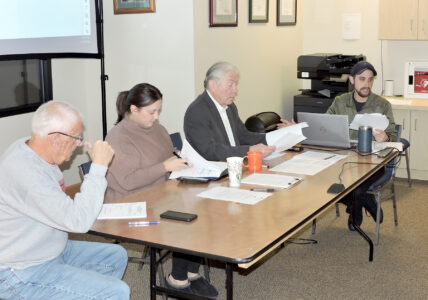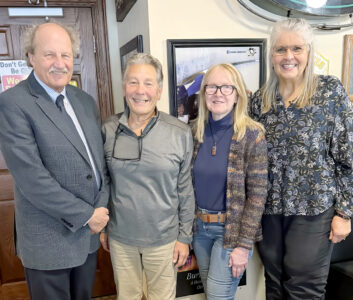West Virginia shows improvement on broadband expansion
Awaiting approval of federal broadband plan
CHARLESTON — West Virginia remains one of the worst states for access to high-speed broadband, but an influx of federal funding over the last five years has helped the state become one of the most improved for broadband connectivity.
Members of the West Virginia Broadband Enhancement Council received a report Wednesday during its regular meeting on the progress of broadband projects in 2025 presented by Kaitlyn Bolin, a broadband consultant for Tilson, a consulting company.
According to data presented by Bolin from U.S. Census data, West Virginia was the least connected state and territory in the nation, behind Mississippi and Puerto Rico. According to the report, 89.4 percent of households in West Virginia have access to some form of broadband, while the national rate was 93.2 percent.
However, based on the U.S. Census data, Bolin said that West Virginia was the most improved state for the percentage of households with broadband subscriptions between 2023 and 2024, improving by 2.6 percent; and in the top six states for the percentage of households with broadband subscriptions between 2017 and 2024, improving by 13.7 percent which was ahead of the U.S. average of 9.7 percent.
“West Virginia has been consistently most improved when you assess how that percentage has changed over time, both since 2023 and since 2017,” Bolin said. “While connectivity is still needed in many areas of the state…West Virginia leads the U.S. in internet growth since 2023.”
According to the report presented by Bolin, broadband availability growth increased in West Virginia by 245 percent over a five-year period, from 200,776 locations in 2019 to 693,139 locations in 2024. The state also saw improvements in speed tests – which determine how quickly data is being uploaded and downloaded over broadband – in 2022, 2023, 2024. Download speeds have increased by 83 percent and upload speeds have increased by 37 percent since 2022.
“Many of the areas that were previously experiencing 50 megabits per second or less under the best conditions have now been consistently recorded with 300 megabits per second or above,” Bolin said. “So, you can really see the difference there in the last three years. We can also see increased download and upload speeds across different regions of the state, and that’s also through 249 unique providers that are in those recorded speed tests.”
This progress is due to several federal funding streams for high-speed broadband since 2020. More than $205 million in American Rescue Plan Act (ARPA) grant dollars are funding 47 projects in West Virginia, with 25 projects under construction.
ARPA projects have deployed 1,148 miles of fiber to 9,013 locations through the Capital Projects Fund and the State and Local Fiscal Recovery Fund. Internet service providers have until Dec. 31, 2026, to finish the projects before any remaining funding is clawed back by the U.S. Treasury Department.
The state’s Wireless Internet Networks Program, using $10 million appropriated by the Legislature through the state Division of Natural Resources, has added broadband connectivity to state parks and forests, with nine projects using fiber and five projects using the Starlink low-earth orbit (LEO) satellite internet service.
Projects through the Federal Communication Commission’s Rural Digital Opportunity Fund (RDOF) continue on, with Bridgeport-based Citynet meeting a three-year service milestone in 2024 for serving 5,646 locations, or 42 percent of its goal, with Frontier (now Verizon) on track in 2026 for reporting 16,399, or 21 percent of its RDOF goal. Other projects funded through the U.S. Department of Agriculture, community development block grants, and the Appalachian Regional Commission are ongoing.
“I just want to say how incredibly proud I am of the Office of Broadband, the internet service providers, the Legislature for appropriating the funds a few years ago, and just everyone who has been a part of this team, including the council, to get us to where we are,” said state Sen. Robbie Morris, R-Randolph, the former chairman of the Broadband Enhancement Council.
“This is just incredible,” Morris continued. “It’s just accelerating now that we’re getting over these hurdles and ISPs are able to construct broadband, construct their fiber projects and get citizens connected. It’s only going to go up from there.”
Now, West Virginia is awaiting approval from the U.S. Department of Commerce’s National Telecommunications and Information Administration for its $625 million Broadband Equity, Access and Deployment (BEAD) application, which was submitted at the beginning of September.
The BEAD Program, established by the Infrastructure Investment and Jobs Act (IIJA), allocated more than $42 billion to expand high-speed broadband access across the United States. West Virginia was awarded $1.2 billion by the NTIA in 2023. The state was granted a 90-day extension in March to submit the state’s final BEAD grant proposal following a pause placed on the program by Commerce Secretary Howard Lutnick.
According to the state’s BEAD draft final proposal, the West Virginia Office of Broadband within the state Department of Commerce will award $625 million of the $1.2 billion BEAD grant to nine provisional subgrantees to expand high-speed broadband to nearly 74,000 locations across the state.
Kelly Workman, director of broadband, told the council Wednesday that the NTIA was beginning to announce BEAD application approvals.
“We are really encouraged to see that, and I’m looking forward to NTIA approval for West Virginia in due course,” Workman said. “And as you know, we continue to be responsive to NTIA for any and all inquiries that they may have for our agency on behalf of the state. We’re happy to continue working with NTIA to reach approval.
“We’re optimistic and really happy to see the approvals come forward this week and looking forward to (receiving) that approval soon and then moving into 2026 and implementing BEAD in West Virginia,” Workman continued. “Things are rolling right along. We’ve worked very hard to get into a good position to be ready for BEAD, trying to get as many projects funded under ARPA to construction. Because we know what’s coming next.”



